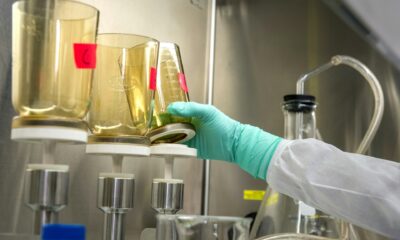Biotech
Biotechs receive one-third of the milestone payments provided for in licensing agreements
In the biotechnology sector, buyouts and licensing agreements are almost always accompanied by development milestones and other milestone payments. Analysts have attempted to quantify the share of these price supplements actually received by biotech companies over a period of about ten years. The result is that about one-third of milestone payments are being paid.

Agreements at several hundred million dollars or even more than a billion dollars to acquire the rights to an experimental treatment under development at a biotech company are commonplace in biotechnology. In fact, most are now structured with an upfront payment followed by milestone payments.
Pharmaceutical giant Roche, for example, acquired last month a “breakthrough” anti-fibrotic drug for $390 million and up to $1 billion in possible top-up payments. In December, the Swiss group also acquired the worldwide rights to Sarepta’s gene therapy for Duchenne muscular dystrophy from the U.S. for $1.15 billion in cash, plus $1.7 billion in earn-out payments.
SRS Acquiom’s analysts have attempted to track and quantify the actual payments (conditional on the successful clinical, regulatory and commercial development of a project). Starting with the name of the sellers – the biotechs – the platform followed the progress of the buyers – the pharmaceutical companies, finally offering an overview of the future of the predicted “milestones” from a solid sample.
Published last September, this report proves first of all that these earnouts generally in the form of milestone payments linked to the achievement of clinical milestones, still feature in the vast majority of transactions (approximately 84% over the period 2017-2019).
Get the latest biotechnology news at your fingertips. Discover what is new in biotech research, finance, business, and more with Born2Invest. Our companion app includes news updates of economic headlines from fin-tech to investing and cannabis.
One-third of milestone payments paid
Overall, about one-third of these steps are paid for. For Don Morrissey, head of life sciences at SRS, this share is a sufficient success to justify the pharmaceutical industry’s decision to increase these price supplements and to outsource R&D to biotechnology. In an interview with Endpoints News last September, Don Morrissey said that “these steps have always made sense,” adding that companies prefer to make four transactions with significant milestones knowing that only one will succeed, rather than trying to choose which of the four will be successful.
In total, out of the 100 transactions studied by SRS Acquiom, the ratio between potential gains and starting value is around 3 to 1 and this ratio has tripled since the 2012-2014 period. In total, out of the 100 deals, milestone payments potentially amounted to $7.5 billion and $2.7 billion was actually paid. Some of the remaining $5.8 billion is still pending (17%) but as most of the clinical milestones have not been achieved, 50% of the planned price complements will never be paid out.
“The success you see – even though only 33% of milestone payments have been made – is very mixed and involves all kinds of different diseases,” said Don Morrisey, according to whom “this data validates the pharmaceutical industry’s outsourcing strategy.”
“Short-term milestones are carefully negotiated and vendors prioritize them so that they can be achieved,” said Morrissey, who noted that these first installments are affected about 50% of the time. Short-term milestones are reached more rarely, but the final pre-clinical milestones are more likely to be met.
In detail, 60% of pre-clinical milestones, 44% of Phase 1 milestones, 30% of Phase 2 milestones and only 29% of Phase 3 milestones have been achieved, but the latter represent some $833 million (out of $2.6 billion) versus $430 million (out of a potential $667 million) received by biotechs in pre-clinical (prior to human trials) milestones.
__
(Featured image by Sharon McCutcheon via Unsplash)
DISCLAIMER: This article was written by a third party contributor and does not reflect the opinion of Born2Invest, its management, staff or its associates. Please review our disclaimer for more information.
This article may include forward-looking statements. These forward-looking statements generally are identified by the words “believe,” “project,” “estimate,” “become,” “plan,” “will,” and similar expressions. These forward-looking statements involve known and unknown risks as well as uncertainties, including those discussed in the following cautionary statements and elsewhere in this article and on this site. Although the Company may believe that its expectations are based on reasonable assumptions, the actual results that the Company may achieve may differ materially from any forward-looking statements, which reflect the opinions of the management of the Company only as of the date hereof. Additionally, please make sure to read these important disclosures.
First published in BFMBOURSE, a third-party contributor translated and adapted the article from the original. In case of discrepancy, the original will prevail.
Although we made reasonable efforts to provide accurate translations, some parts may be incorrect. Born2Invest assumes no responsibility for errors, omissions or ambiguities in the translations provided on this website. Any person or entity relying on translated content does so at their own risk. Born2Invest is not responsible for losses caused by such reliance on the accuracy or reliability of translated information. If you wish to report an error or inaccuracy in the translation, we encourage you to contact us.

-

 Markets2 weeks ago
Markets2 weeks agoThe Big Beautiful Bill: Market Highs Mask Debt and Divergence
-

 Africa2 days ago
Africa2 days agoORA Technologies Secures $7.5M from Local Investors, Boosting Morocco’s Tech Independence
-

 Markets1 week ago
Markets1 week agoA Chaotic, But Good Stock Market Halfway Through 2025
-

 Business4 days ago
Business4 days agoThe Dow Jones Teeters Near All-Time High as Market Risks Mount

























